Please choose your country or region so we can show you the most relevant content.
It looks like you are in United States? Accept
Africa
- Algeria
- Angola
- Benin
- Botswana
- Burkina Faso
- Burundi
- Cabo Verde
- Cameroon
- Central African Republic
- Chad
- Comoros
- Congo
- Côte d'Ivoire
- Djibouti
- DR Congo
- Equatorial Guinea
- Eritrea
- Eswatini
- Ethiopia
- Gabon
- Gambia
- Ghana
- Guinea
- Guinea-Bissau
- Kenya
- Lesotho
- Liberia
Asia
Australasia
Europe
- Albania
- Andorra
- Austria
- Belarus
- Belgium
- Bosnia and Herzegovina
- Bulgaria
- Croatia
- Czechia
- Denmark
- Estonia
- Finland
- France
- Germany
- Greece
- Greenland
- Holy See
- Hungary
- Iceland
- Ireland
- Italy
- Latvia
- Liechtenstein
- Lithuania
North America
Middle East
In the previous episode of the Tentipi Blog, outdoor photographer and writer Tim Gent took us out to his top places for canoe camping in Scotland. Together with his wife, photographer Susannah Gent, Tim spends an impressive amount of time out in the outdoors and the couple have grown a special relationship to the wilderness of both northern Britain and Scandinavia. A matter of fact, we here at the Tentipi headquarters in Sunne, Sweden feel that it’s not summer until we’ve seen the Gents’ camper van with the green Wenonah canoe strapped onto the roof drive up our parkway. For us office guys it’s a breath of fresh air to have them over for coffee and to hear about where next they’ll take their Safir 7bp for camping. Now we invite you to join our “coffee break” and to hear Tim’s top places for canoe camping in Scandinavia!
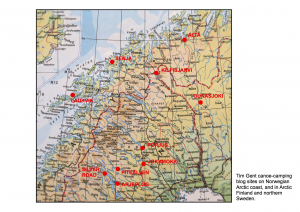 Norwegian Arctic coast
Norwegian Arctic coast
We have a fairly odd relationship with Norway. Despite a number of visits, Susannah and I have never been much farther south than Mo I Rana. We don’t feel we’ve missed out.
Our first visit was over the mountains from Abisko in Sweden, arriving at the vast fjord that holds Narvik. Within minutes we were on the water. After only a few moments more, lunch was caught and we were soon cooking mackerel over driftwood on the shingle beach, an eagle floating high overhead.
Since that fine introduction we’ve meandered amidst the German and Dutch campervans along the main coast road, turning off to explore whenever possible. It’s a vast area, and the opportunities are almost endless. Despite a quite few visits, we’ve barely tickled the surface.
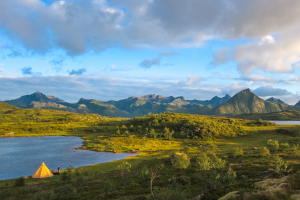 In brief, the Lofotens, as you may have heard, are quite simply breath-taking, and we found some wonderful camping possibilities to the south of Laukvik. But this outstretched arm of interlinked isles isn’t the quietest part of what can be a surprisingly busy coastline.
In brief, the Lofotens, as you may have heard, are quite simply breath-taking, and we found some wonderful camping possibilities to the south of Laukvik. But this outstretched arm of interlinked isles isn’t the quietest part of what can be a surprisingly busy coastline.
Farther north, working our way from one island to another (by ferry I should add, not canoe), we both rather fell for Senja. If nothing else, this generous multi-fingered hand of an island provided some of the most amazing sunsets we’ve seen, and that’s saying something.
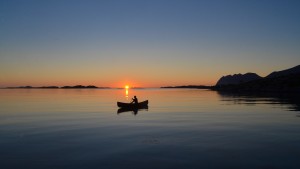 And not just because it represents the most northerly point we’ve camped, the coastline to the north and east of Alta was quite spectacular, as was the fishing. We found it hard to leave.
And not just because it represents the most northerly point we’ve camped, the coastline to the north and east of Alta was quite spectacular, as was the fishing. We found it hard to leave.
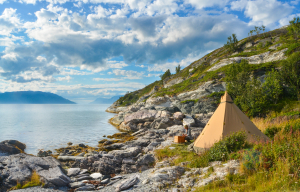 My tips for the area: For somewhere so far north, it can come as quite a surprise to find out how many houses there are, spread albeit thin along almost the whole length of the few roads that meet water. In search of a truly wild spot to camp, look on your map for those fjords with a road on only one side, or better still, a road that meets just the head of a sheltered expanse of sea. The roadless empty shore, or if lucky, shores, will usually provide somewhere quiet to pitch a tent.
My tips for the area: For somewhere so far north, it can come as quite a surprise to find out how many houses there are, spread albeit thin along almost the whole length of the few roads that meet water. In search of a truly wild spot to camp, look on your map for those fjords with a road on only one side, or better still, a road that meets just the head of a sheltered expanse of sea. The roadless empty shore, or if lucky, shores, will usually provide somewhere quiet to pitch a tent.
And if you are thinking of driving up yourself, consider travelling through Sweden. On first visiting Narvik’s fjord we informed an incredulous pair of camper van drivers that we had set out from southern Sweden only four days earlier. It had taken them over two weeks to wend their way along the windy single road that runs along the edge of every fjord of the Norwegian coast from Oslo.
Arctic Finland
As with Norway, our knowledge of Finland is extremely skewed, and probably fairly unusual. We’ve only ever arrived from the north, we’ve never been south of Tornio, and we only reached this far below the Arctic Circle this summer. Our knowledge of the whole country is based then, solely on this north-west corner. That’s good enough though. If you have a canoe and a tent, and you like the wild, head for Arctic Finland.
We found ourselves camping in the shadow of Sanna near Kilpisjarvi this summer, right up in the corner, paddling out and around to visit the yellow concrete lump that marks the point where Sweden, Norway and Finland meet. We found it hard to leave.
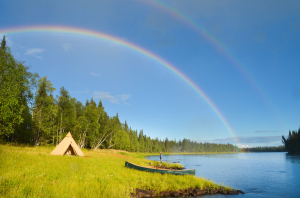 Leaving aside all the wonderful lakes for a moment, any of which would be worth exploring by canoe, one river stands out. We didn’t spend long on the upper Ounasjoki, that flows south, growing on its way to meet the Kemijoki, but we saw enough to make this one of our favourite canoe-camping discoveries. Perhaps this has much to do with its sense of remoteness for a couple from south-west England. It’s certainly the most far-flung river we’ve camped on. I suspect though that it has much to do with the fact that it is just very beautiful. There is a helpful A4 pamphlet (Ounasjoki. Free-Flowing Experiences), published by the Finnish tourism people, that describes the river and its tributaries, with maps showing launch spots and graded rapids, most of which can be run in usual flows.
Leaving aside all the wonderful lakes for a moment, any of which would be worth exploring by canoe, one river stands out. We didn’t spend long on the upper Ounasjoki, that flows south, growing on its way to meet the Kemijoki, but we saw enough to make this one of our favourite canoe-camping discoveries. Perhaps this has much to do with its sense of remoteness for a couple from south-west England. It’s certainly the most far-flung river we’ve camped on. I suspect though that it has much to do with the fact that it is just very beautiful. There is a helpful A4 pamphlet (Ounasjoki. Free-Flowing Experiences), published by the Finnish tourism people, that describes the river and its tributaries, with maps showing launch spots and graded rapids, most of which can be run in usual flows.
My tip for the area: Try not to be in a hurry to leave too soon. Find somewhere quiet for yourself and wait until the trees, hills, and streams begin to talk.
Northern Sweden
Best till last? That’s a tricky one, and I really don’t care much for rankings anyway, but Sweden does hold a very special place in our affections.
And for a change, I’m going to mention people. For while we tend to go out of our way (and any one else’s) on our trips to avoid settlements, this seems to be far less of a concern here. Partly this must be due to population densities, and there’s no doubt that as we travel north, and the villages and towns shrink, we feel more sympathetic towards them, but it is also due to the individuals we meet. Not, I hasten to add should this be seen as any slur on those we meet elsewhere up there. On the whole, we’ve met with only generosity and friendliness in all the countries of Scandinavia. If anything, the openness of the Finns, and cheer of the Norwegians is hard to beat.
It is perhaps the attitude to the land in Sweden that has such a bearing on our affection for the country. Swedes really do love their land. Just as importantly, they seem to want others to experience and love it too. Nowhere that we have travelled, with a canoe, from the Balkans and the Iberian peninsular, to way above the Arctic Circle, have we felt as if our presence with a canoe and tent is not just tolerated, but encouraged and welcomed.
Anyway, back to the land, the rivers, the lakes. And boy is there a lot of it. Only by driving up through Sweden, from the bridge landing near Malmö until the roads finally tipping over into northern Norway or Finland can you grasp this fully. Along this ribbon of tarmac, stretched out between the pine and birch are countless rivers, and simply thousands of lakes, and you can launch onto any deep enough to float your hull. Add to this the island-strewn coast, on both sides, and you have something of a canoe campers’ paradise.
But enough of the waffle, you’d like to know where to pitch that tipi.
Well my advice is pretty simple. Pick any river valley heading off from the wonderful E45 towards the mountain border with Norway. Then start exploring. Almost any turn left will do, particularly making your way uphill from Vilhelmina, Storuman, Sorsele or Kiruna. Each will provide you with wonderful canoe camping opportunities. If forced to pick two spots, from which to break away towards the hills, it would be Jokkmokk and Porjus.
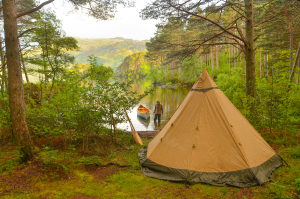 And if I had to choose just one area to canoe camp in northern Sweden, it would have to be the municipality of Arjeplog.
And if I had to choose just one area to canoe camp in northern Sweden, it would have to be the municipality of Arjeplog.
I could provide all the statistics, the comparisons with the size of Belgium (much the same), the number of people (hardly any) compared to the number of lakes (thousands), but even having written about all this before, and having paddled here for what must now add up to quite a few weeks, it still didn’t really sink in until this autumn.
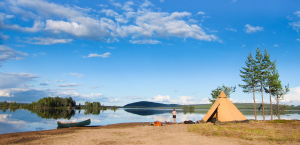 Just before leaving this wonderful area, we drove to the top of Gáldesbuovdda. From the not very pretty 800m top of this lofty hill, the views stretch out to distant horizons in every direction. And most of it is taken up by water. Rivers, lakes, rivers that look like lakes, tiny streams, scattered everywhere. Apart from the telecommunications towers stood close alongside, and Arjeplog itself, tiny below, you can spot just a couple of roads. Otherwise, evidence of man is utterly absent. And all of this water is freely accessible, almost anywhere on the shore available to camp. I can’t actually imagine a finer place to set out with a tent stored at the bottom of your canoe.
Just before leaving this wonderful area, we drove to the top of Gáldesbuovdda. From the not very pretty 800m top of this lofty hill, the views stretch out to distant horizons in every direction. And most of it is taken up by water. Rivers, lakes, rivers that look like lakes, tiny streams, scattered everywhere. Apart from the telecommunications towers stood close alongside, and Arjeplog itself, tiny below, you can spot just a couple of roads. Otherwise, evidence of man is utterly absent. And all of this water is freely accessible, almost anywhere on the shore available to camp. I can’t actually imagine a finer place to set out with a tent stored at the bottom of your canoe.
Should this still be a little imprecise, just find somewhere to launch onto the Piteälven, and set out to explore this ribbon of fresh water, strung with bright lakes beneath a shimmering sky.
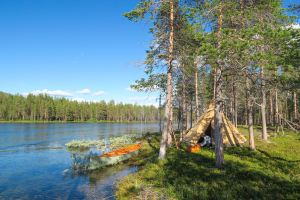 For those who don’t mind, or even prefer, their trips to be a little closer to a main thoroughfare, I am happy to suggest the Silver Road. This heads north-west from the town of Arjeplog, and when frozen in winter was once used to transport this precious metal up over the mountains. The glorious collection of interlinked lakes that run alongside this road can now transport you and your equally precious temporary home.
For those who don’t mind, or even prefer, their trips to be a little closer to a main thoroughfare, I am happy to suggest the Silver Road. This heads north-west from the town of Arjeplog, and when frozen in winter was once used to transport this precious metal up over the mountains. The glorious collection of interlinked lakes that run alongside this road can now transport you and your equally precious temporary home.
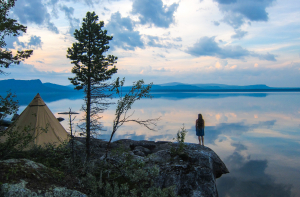 Our first night in a tent up there was spent on an island set close to the border with Norway, and almost smack on the Arctic Circle. As the sun inched across our campsite in the morning, a small flock of resident bluethroats gathered to watch, fascinated by the two southern migrants they’d found cooking breakfast on the beach.
Our first night in a tent up there was spent on an island set close to the border with Norway, and almost smack on the Arctic Circle. As the sun inched across our campsite in the morning, a small flock of resident bluethroats gathered to watch, fascinated by the two southern migrants they’d found cooking breakfast on the beach.
My tip for the area:
If you like eating fish, take a rod, or at least a handline. Fishing licenses are often very good value up there, and a silver Mepps or copper Toby, trolled behind your canoe as you move from campsite to campsite, rarely fails to provide the next meal.
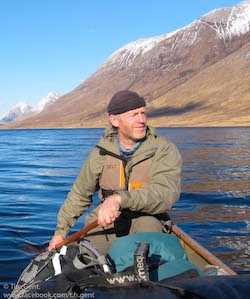 Tim Gent is a British outdoor writer and photographer, writing about fishing, hillwalking, canoeing and camping. He had the first of many magazine articles published in 1990 and he is a regular contributor to Canoe and Kayak UK and Bushcraft and Survival Skills, and often writes for The Great Outdoors. His photography can also be seen on Tentipi catalogues, website and social medias.When not camping, Tim and his wife, photographer Susannah live in Devon, England, midway between Dartmoor and the Atlantic coast. Read more at http://www.timgentoutdoors.com
Tim Gent is a British outdoor writer and photographer, writing about fishing, hillwalking, canoeing and camping. He had the first of many magazine articles published in 1990 and he is a regular contributor to Canoe and Kayak UK and Bushcraft and Survival Skills, and often writes for The Great Outdoors. His photography can also be seen on Tentipi catalogues, website and social medias.When not camping, Tim and his wife, photographer Susannah live in Devon, England, midway between Dartmoor and the Atlantic coast. Read more at http://www.timgentoutdoors.com
Related blog posts
Wouldn't it be exciting to spend the night right in the middle of a zoo? – That is exactly what you can do at Skånes Djurpark, a wildlife park in southern Sweden. At their campsite, Camp Oak, you stay in the park after it closes and will make yourself at home in a Nordic tipi from Tentipi. When the night comes you might just fall asleep to the wolves’ howls.
Skånes Djurpark is a Wildlife Park with a long history, it dates back to 1952. It focuses on animals from the Nordic area and has always lived by the ruling with “no animals in cages”. The animals live in large paddocks that recreates the animals’ natural environments.
Sapmi Nature Camp – Sami culture and glamping in the arctic
木曜日 30 12月 2021
Lennart Pittja is a Sámi entrepreneur with a mission: with his world-renowned eco-tourism company he wants to spread the knowledge about his people – the Sami, indigenous of northern Scandinavia and Russia. With over 20 years of experience as a wildlife guide and nature photographer in the arctic region he started Sápmi Nature Camp. Where his guests stay in Nordic tipis from Tentipi on his reindeer herding land outside of Gällivare, in northern Sweden.
At Sapmi Nature camp you can experience real winter, see the northern lights, eat traditional Sami food, and have a cultural exchange in a genuine atmosphere. The scenic location has gained attraction from around the world. In 2017 it was listed by National Geographic as one of the top 21 places in the world to visit if you care about the planet.
Discovering the world’s most remote places with Mike Fuchs
木曜日 17 6月 2021
It was the first day of the trip, adventurer Mike Fuchs and his friend Eric Folz had just a couple of hours before been dropped off as far north as they could possibly come in Svalbard when they saw them. Two polar bears, one mother and its cub. A situation that could become deadly if the bears decided to have a closer look on their new visitors.
“I know how protective the mothers can be of their cubs. We had to set up our camp in a place that provided a good overview of the location so we could spend the night bear watching. It was both a scary feeling seeing them so early into our trip, but it was also very fascinating”, says Mike Fuchs.
Nine things you need to know about winter camping
水曜日 5 5月 2021
Prepare before setting out for winter camping. Here are nine tips and tricks from Tentipi about what you need to think of before you go: the right tent for winter camping, how to pack the snow, comfort in snow, which tent pegs to use, where to pitch the tent, about snow weight, what heat sources can be combined with the tent, how to make a fire safely and other equipment.
Choose tents according to occasion, different tent types work differently at winter camping. When it’s icy, the tent needs to be more robust than a tent which is exclusively used in summer. The tent frame needs to withstand a certain amount of snow and functional ventilation is important. If you want to use a heat source, for example a fireplace or a stove, the tent needs to have ventilation openings both at ground level and at the top. Without a heat source, a smaller tent is preferable, as it heats up faster when the air volume is smaller.
A tent from Tentipi is a Nordic tipi and the tent has eight or nine sides, if it is not the smallest that has six sides. In the smallest tent you can stand straight if you are less than 160 centimetres long and in the largest you can get together several thousand people. The tent is versatile in more ways. Continue to read to see why these tents are so flexible and adaptable. This blog post is about the smaller tents in Tentipi's range, tents used by adventurers, families, hikers and others who want to live close to nature for a shorter or longer period of time.
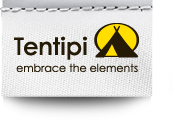
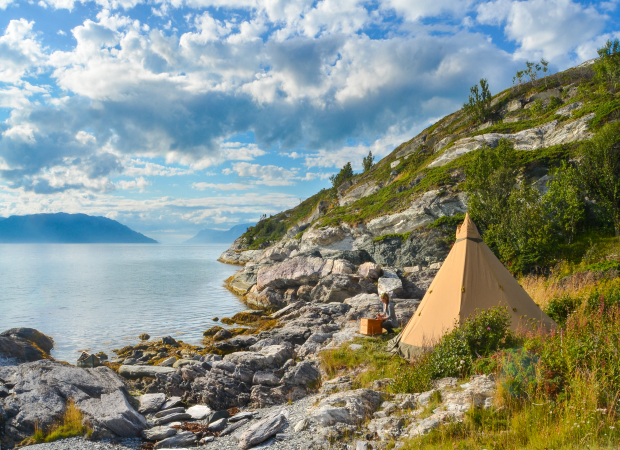





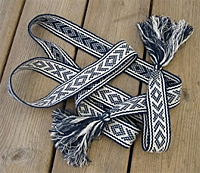


Please click the 'Add comment' button below if you wish to comment.